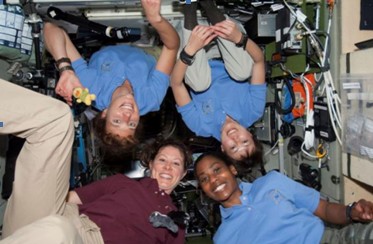
Astronaut sneezes are biggest risk to long distance space fl
usinfo | 2012-12-29 09:28

Forget aliens, sneezing on a rocket could be the biggest risk to long-distance space flight, claim scientists.
Zero gravity causes germs to float around for ages, increasing the risk of infection for astronauts.
When someone sneezes or coughs on Earth, the germs fall to the ground within three to six feet, but without gravity they just float around infecting more surfaces.
Apollo XI astronauts, from left, Neil Armstrong, Michael Collins and Buzz Aldrin laughing with President Richard Nixon aboard the USS Hornet. Researchers now say the biggest obstacle for long haul astronauts could be sneezing
And in a spacecraft, power limitations prevent extensive air filtration and the air is recirculated, meaning astronauts cannot use some hospital disinfectants and hand hygiene products as they could emit hazardous vapours.
Scientists compare the many surfaces in the closed quarters of a spaceship to a university dorm room or bathroom, as they act as reservoirs for germs that can spread in the unique environment.
Dr Leonard Mermel, of Brown University, USA, explained: ‘So you suppress the human immune response, and you enhance the ability of microbes to cause infection, and you put those together in a confined space where airborne particles can remain in the air for a protracted period of time.’
Although there is not much data on the risk of infectious disease on space missions, he found NASA statistics showing there have been 29 reported incidents among 742 crew members on 106 space shuttle flights.
Dr Mermel asked: ‘What if there was something that happened that put someone at risk?
‘Could they, or would they, turn around before they accomplished their mission?’
When it comes to prolonged space flight, he reasons the best strategy for dealing with germs would be to enhance the considerable prevention methods NASA already has in place.
Currently, NASA vaccinate astronauts for several diseases – including the flu – and screen for others – such as tuberculosis – and astronauts have disinfecting wipes, surgical masks and respirators, and take off with multiple antibiotics on board.
Astronauts currently aboard the International Space Station: New research found that is astronauts sneeze, germs can remain in circulation as their air system is closed.
But Dr Mermel believes jabs could be expanded to include germs like Meningococcus, which causes meningitis, and Pneumoccocus, which causes pneumonia.
And as no new germs are going to join the astronauts on board once they take off, expanded pre-flight screening may help too – looking for all strains of Staphyloccocus aureus, which can cause a range of infections, from pimples and boils to life threatening diseases such as endocarditis and toxic shock syndrome.
Stools could also be screened and re-screened for Salmonella and astronauts could receive formal infection control education regarding hand hygiene, environmental cleaning, and other healthy practices.
And in the study – published in the journal Clinical Infectious Diseases – Dr Mermel says working air filtration into the energy budget would be worthwhile, as well as toilets operated with foot pedals.
Dr Mermel said: ‘I’ve been involved for two decades with trying to prevent infections in the intensive care unit and general hospital settings and I’ve been involved with national and international guidelines, but there are a lot of constraints in space I had never thought of before.’
Share this page



















